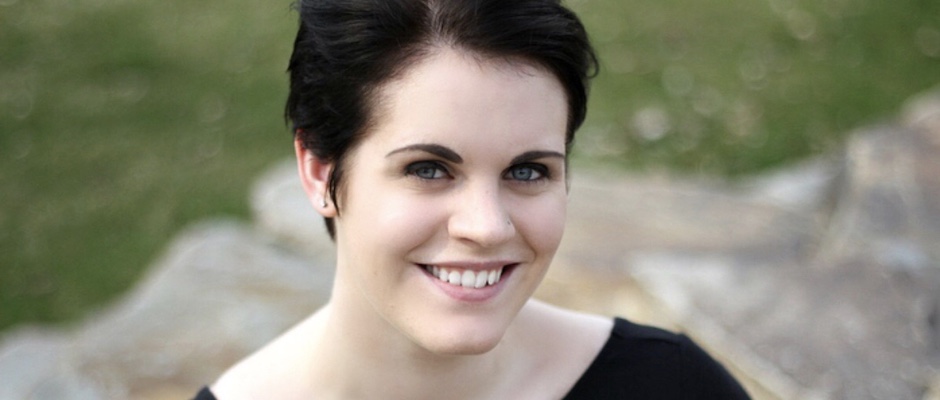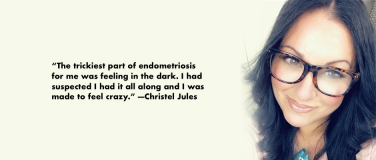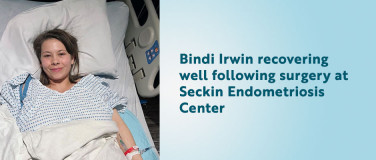
“So. Tell me about your pain.”
The resident’s words are so unfamiliar—unexpected and yet entirely welcome—that I can’t help myself; I immediately burst into tears.
It’s late March of 2019. I am seeing the doctor who works with this resident for the first time. I am a year out from a surgery that failed to fix me. I never expected to be back here, explaining myself to yet another medical professional.
I am the one in ten people with uteruses who has endometriosis. I’ve known something was wrong since the age of 12 but never even heard the word endometriosis until I was 18, wasn’t diagnosed until 24, and didn’t find a competent doctor until 25. The thirteen years between onset and complete care were a blur of pain and misery and failed treatments, unexpected hospital visits and invasive tests, a revolving door of nurses and technicians and doctors who refused to hear me.
2006, 12-years-old
The blood in my underwear makes me feel like a grown up. This feels like progress. I have no idea what it will actually mean.
I am two periods into my newfound adulthood and I am kept awake by a dull ache in my abdomen. I’ve never felt a pain like it before. It isn’t overbearing, just new and different.
2007-2011, 13-17-years-old
The remainder of my teenage years are marked by monthly battles against my body that begin to stretch outside the ten days I bleed. Cramps become mandatory; ibuprofen doesn’t cure them, acetaminophen doesn’t cure them, so I muscle through. Everyone gets cramps, right?
What everyone doesn’t get are hot flashes at the age of 13, back pain that makes it hard to stand for long periods of time, bloating so severe I keep a certain pair of pants expressly for that point of the month, clots that come out of my body and force me to double over in pain.
Repeated trips to Doctor #1—even an ER visit for suspected appendicitis—are met with dismissal. “Some people are just like that,” Doctor #1 tells me. I’m frustrated, but she’s the doctor. Wouldn’t she tell me if something was wrong?
Eventually, I stop asking for help.
In high school, my yet-undiagnosed anxiety disorder hits me with full force, compounded by my monthly battle with pain. I start skipping show choir rehearsals so I can go home and rest. My director asks if this is more of a commitment than I can handle. All I’ve ever wanted to do is perform. This is the first time my body has threatened to take something I love away.
It’s getting harder to accept this as normal.
2012, 18-years-old
My first semester of college is a haze of pain and anxiety. I visit the campus clinic and hear the word ‘endometriosis’ for the first time. I look up this new word and see myself in the symptoms. Severe pain, bloating, nausea, heavy bleeding, it’s all there. I’m not just “like this,” something is actually wrong with my body. This feels like validation.
A couple weeks later I’m driven to the ER by back pain that kept me awake. Doctor #2, a medical resident, puts his hands and a metal device inside a part of my body that no one has ever touched. I am mortified. He pokes and prods, asking if anything hurts, but I’m so overwhelmed I can’t pick out anything specific. Doctor #3, the overworked attending, comes back to declare that my ultrasound is clear and I should be sent home. She dismisses me without ever addressing me directly.
Doctor #2 sends me off with literature about mittelschmerz and a prescription… for 800mg strength ibuprofen.
My first prescription for birth control is a disaster. I bleed for 32 days straight and become so nauseated that I stop eating and lose 15 pounds. My already heightened anxiety spirals into a depression that leaves this straight A, perfectionist student skipping class.
Doctor #1 sends me to Doctor #4, and I ask her about endometriosis. She says my symptoms are consistent, but insists there’s nothing she can do. She explains that you can only diagnose endo through surgery, and then the only treatment is birth control, so why bother? I believe her, despite the fact that she never examines me and basically sends me out the door with a shrug. She’s the doctor. Wouldn’t she give me options if I had them?
2013, 19-years-old
My second prescription for birth control leaves me in so much pain I’m driven to tears. My ten day period shortens to eight, which is enough for Doctor #1 to call it a success, despite the other misery. Armed with a recent diagnosis of generalized anxiety disorder, my mental health has improved, but not enough. I decide that if I’m going to be miserable on or off birth control, I’d rather be miserable off. I convince myself that’s why I stop asking for help. In reality, I am sick of doctors making me feel small.
2014-2016, 20-22-years-old
Chronic pain becomes the theme of my life. I operate under the assumption that I have endometriosis with no options for treatment. I spend three years like this, pushing through the pain, and never seeing doctors if I can help it. This is life; I’m resigned to it.
2017, 23-years-old
I stop bleeding in the traditional sense, instead passing clots in various shades of red. My period is shorter, but the pain is far more intense. I decided it’s time to try again. Doctor #5 nods sympathetically and recommends an IUD.
The insertion is a disaster. It’s the worst pain I have ever felt, and given my history, that’s significant. The PA assures me I’m almost done. I reach for the nurse’s hand, and the next thing I know, ammonia is shooting up my nose. The pain is so unbearable that I lose consciousness. The PA gently tells me insertion would be impossible and instead sends me home with a NuvaRing. I don’t realize until I do some research 48-hours later—hormones seeping into my body, too depressed to leave my bedroom—that NuvaRing is not recommended for those with a history of anxiety and depression.
In October of the same year, I’m tech for a show, in so much pain I’m doubled over in the wings, concerned castmates rubbing my back. I barely make it onstage. I decide enough is enough; I can’t go on like this. I repeatedly call Doctor #5’s office. No one ever calls me back.
I instead make an appointment at Planned Parenthood to get a prescription for the minipill, hoping the absence of estrogen will prevent it from wreaking havoc on my anxiety. Before I leave, a nurse takes me aside and says, “If this doesn’t work, you go back to your doctor and DEMAND a diagnosis.”
2018, 24-years-old
To the surprise of exactly no one, the minipill is yet another disaster; I stop taking it within two months. I make an appointment with Doctor #6, one known for treating endometriosis. She agrees: it sounds like I have endometriosis. She is Catholic and therefore doesn’t prescribe birth control for any reason, but she also feels it’s just a bandaid for endo symptoms. She explains that surgery isn’t just for diagnosis; it’s for treatment too.
“It’s important to treat this now,” she says, “because endometriosis can affect your fertility, and of course, you’ll want kids.”
I don’t, but she is the first doctor who’s really listening, so I keep my mouth shut. I leave with orders for ultrasounds, a referral to a surgeon, and a new, cautious sense of hope.
Doctor #7, the surgeon, is a fertility expert well-versed in excising endometriosis. It bothers me that the first doctors to take me seriously are doing so for my irrelevant fertility and not my wellbeing. He performs an exam and has me circle all of the places I experience pain on a chart. He says this seems like endometriosis, but he sounds skeptical. We schedule the surgery anyway.
The day of my surgery, I am nervous, but hopeful. The second I am reunited with my mother I ask, “Did he find anything?” He did. He found endometrial implants everywhere I indicated pain. He told my mother that he was surprised by how much he found, and that they were incredibly thorough in the excision; “There’s a less than 10% chance this is ever going to recur.”
The next few months are rough. My pain and bleeding increase, and I welcome a flood of new gastrointestinal symptoms. In October, I wake up in the middle of the night in so much pain I cannot move. This is the six-month mark, the point at which I’m supposed to be feeling relief. This feels like defeat.
2019, 25-years-old
I had a lot of post-op scenarios in my head. In not one of them did my symptoms get worse. Waking up in too much pain to move has become a monthly occurrence. Cramps, while unbearable before, now feel like my uterus is filled with acid.
I search through every OB/GYN in the area until I find Doctor #8, the only one who mentions endometriosis in her profile. This is how I find myself crying in her exam room, explaining my fraught history with birth control, the doctors who have dismissed me, and everything that has brought me to this day. She is a kind-faced woman who I like immediately. She is attentive and validating, laying blame on my past surgeon for incomplete care. She says I should’ve been taking hormones to prevent recurrence this whole time, something the Catholic surgeon never mentioned. She offers several treatment plans, some as radical as a full hysterectomy. She prioritizes my quality of life over everything. Most significantly, she talks to me like I am chronically ill. She is the first doctor in eight to acknowledge that this may take time before I feel good. “And,” she promises, “we’ll get you there!”
We.
Together, we decide on a treatment plan.
This feels like healing.
Today
I’m 27 now, six months out from my second surgery. Doctor #8’s first treatment plan wasn’t successful, so we tried something else. Then something else. Then she listened when I said I thought it was time for another surgery. This time, she not only excised endometriosis, but agreed to remove my right ovary and fallopian tube, the site of severe pain for years.
I am better, but not good. I am learning to live with my body instead of fighting it, moving towards acceptance instead of resignation. I try to work with what my body can do instead of berating it for what it can’t. I’m not always successful.
Doctor #8 was the turning point for me, someone I’m grateful for every single day. She always has something new for me to try. At the same time, I am angry. Why did it take this long to find her? Why did it take me eight tries to get it right? I am angry with my doctors, especially with those who put personal beliefs ahead of my wellbeing, but I am more angry at the medical system that left them underprepared to care for me.
In 2019, I appeared in a devised theater piece about the stories our bodies tell. My favorite line, one I wrote, came during a sketch in which I played my own endometriosis. I exclaimed, “No one knows anything about me, because I only affect people with uteruses, and no one cares about people with uteruses!” Then I soaked the rest of the cast with silly string.
Statistically, every other person on this planet has a uterus. One in ten of those people will be affected by endometriosis. This makes endometriosis as common as diabetes. And yet, it takes an average of ten years to get a diagnosis, and there is still no cure.
What’s it going to take for this disease to get the level of care it deserves? At what point does our pain matter? When do we get to heal?
Mel (she/her) is a writer, performer, and human-in-progress. She is fervidly pursuing body positivity and joyful movement while grappling with endometriosis and hopes hearing her story will make others feel less alone. A Pennsylvania native, Mel works for a craft distillery in the Washington, DC area where she lives with her cats, Johnny One Note and Mr. Business.
Editor's note: Would you like to contribute to EndoStories? Click here to learn how to submit your work.
*Patient stories submitted to EndoFound.org are the views of the patient and not necessarily those of the foundation. All testimonials are from real patients, and may not reflect the typical patient’s experience, and are not intended to represent or guarantee that anyone will achieve the same or similar results.









